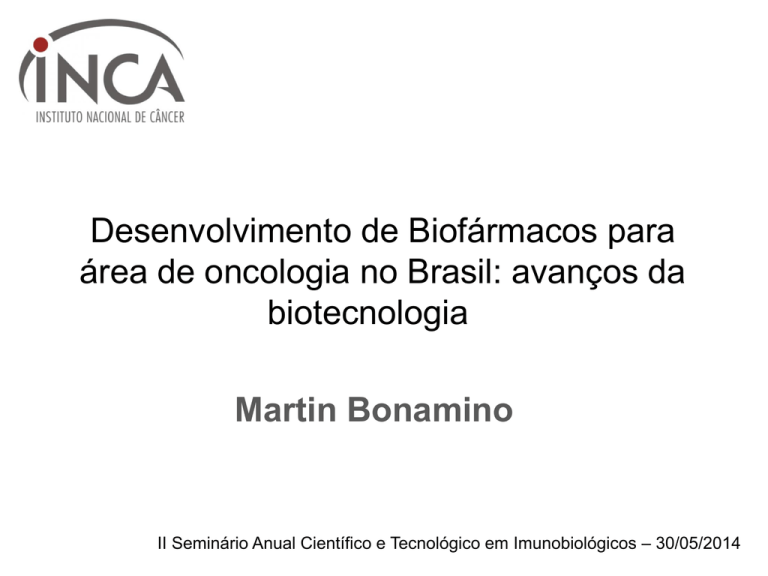
Desenvolvimento de Biofármacos para
área de oncologia no Brasil: avanços da
biotecnologia
Martin Bonamino
II Seminário Anual Científico e Tecnológico em Imunobiológicos – 30/05/2014
Biofármacos - câncer
VEGF
CTLA4
CD20
EGFR
Microambiente tumoral
Biotecnologia como abordagem
para combate ao câncer
•
Bloqueio de fatores estimuladores
•
Anticorpos Monoclonais específicos para o tumor
•
Anticorpos Monoclonais imuno-moduladores
•
Terapia celular/gênica
Scott et al, Nat Rev Cancer 2012
mAbs: estruturas e alternativas
Weidle et al, Cancer Gen Proteom 2013
Anticorpos Monoclonais
tumor como alvo
Rituximab – mAb quimérico anti CD20 - IgG
Rituximab – mAb quimérico anti CD20 - IgG
Anticorpo anti CD20 – Nova geração
www.genmab.com
Cetuximab – mAb quimérico anti EGFR – IgG1
Panitumumab – mAb humanizado anti EGFR – IgG2
Scott et al, Nat Rev Cancer 2012
Scott et al, Nat Rev Cancer 2012
Anticorpos Monoclonais
sistema imune como alvo
Microambiente tumoral
Bloqueio de CTLA-4
T Cell Activation by TCR and
Co-stimulation Through CD28
MHCAntigen TCR
Dendritic
cell
T cell
B7
CD28
CTLA4
CTLA4 Receptors Are Up-Regulated Following
T-Cell Activation
MHCAntigen TCR
Dendritic
cell
T cell
B7
CD28
CTLA4
CTLA4 Negatively Modulates
T-Cell Activation
MHCAntigen TCR
Dendritic
cell
T cell
CD28
B7
CTLA4
Blocking Antibodies to CTLA4 Allow Positive
Signaling from Costimulatory Molecules to T Cells
MHCAntigen TCR
Dendritic
cell
T cell
B7
CD28
CTLA4
Leach DR, Krummel MF, Allison JP. Enhancement of antitumor immunity by CTLA-4 blockade. Science 1996;271:1734-1736.
Adapted from ASCO 2008 meeting. Suzanne Louise Topalian, MD
Ipilimumab Improves Overall Survival
compared to control
Ipi + gp100 (A)
Ipi alone
(B)
gp100 alone (C)
1
2
Years
3
4
Survival Rate
Ipi + gp100 N=403
Ipi + pbo
N=137
gp100 + pbo
N=136
1 year
44%
46%
25%
2 year
22%
24%
14%
What mediates anti-CTLA4-induced
durable tumor regressions?
2005
Durable
response
> 5 years
Blue:
melanoma
Brown:
CD8+ T
cells
Treatment with anti-CTLA4
antibodies
The great majority of responses last years without relapses:
- Longest responder: Ongoing since May 2001
- Response rate: ~10%
Metastatic Melanoma Response to Ipilimumab
Before Ipilimumab
04/22/11
After Ipilimumab
08/05/11
Immunotherapy vs targeted therapy for melanoma
Targeted therapy
Percent alive
Percent alive
Immunotherapy
0
1
Years
2
3
0
1
Years
2
3
Bloqueio de PD1
Células tumorais são capazes de matar
linfócitos efetores infiltrantes
http://www.bmsimmunooncology.com/tumor-immunosuppression.aspx
Expressão de PD-1L por células tumorais
Marcação periférica
Marcação difusa
HPV-Associated Head and Neck Squamous Cell Carcinoma
Lyford-Pike et al. CanRes 2013
Enhancing Immune Responsiveness
PD1 Ab (MDX1106)
Phase I, single dose,
Tolerable, responses in
Colon, Lung, MM, RCC
Brahmer, ASCO 2008
PDL1 Ab
Phase I trial ongoing
PD1 Ab Phase 1,
multi dose, tolerable,
PRs in RCC, MM and
Lung, Sznol, ASCO 2010
Durable partial regression of metastatic kidney
cancer following 3 doses of
anti-PD-1 (10 mg/kg)
01/15/08, pre-Rx
04/22/08
07/22/08
72 year old male with RCC metastatic to lung, LN, muscle, bone,
pancreas. Prior therapies included HDAC inhibitor, sunitinib, and
sorafenib.
Brahmer et al., JCO 2010
Percent Change in Tumor Burden in RCC Patients
*Patients treated with the 10 mg/kg dose
†Upper horizontal line denotes no change; lower horizontal line denotes 30%
decrease (RECIST threshold for PR).
Abbreviations: PR = partial response; RCC = renal cell carcinoma; RECIST = Response Evaluation Criteria in Solid Tumors
34
Outros alvos de intervenção
Kwek et al, Nat Rev Cancer 2012
Combinação de Imunoterapias e Terapias alvo-específicas para Melanoma?
Anticorpos Bi-específicos
Frankel and Baeuerle, Curr Opin Chem Biol 2013
Peptide vaccine
DC vaccine
Genetic vaccine
IL-2
IFN
IL-15
IL-21
CTLA4
PD1
CD40
CD137
OX40
T cell cloning
TCR or CAR
genetic engineerin
Terapia celular
Tumor Infiltrating Lymphocytes
41
Immunotherapy
Rosenberg and Dudley, Curr Opin Immunol 2009
Rosenberg and Dudley, Curr Opin Immunol 2009
ACT: Transferência adotiva de células
NMA: Não Mieloablativo
Terapia gênica
Transferência gênica de TCR
Receptores Quiméricos de Antígenos
(CARs)
Redirecting lymphocyte specificity
for tumor elimination
Chimeric Antigen Receptor (CAR)
MHC-independent
antigen
recognition;
High affinity for the antigen;
Independent
of
patient-
derived TILs
Adapted from Pule et al, 2003
T lymphocyte activation
Multiple signals required
Chimeric Antigen Receptor (CAR)
1st
generation
2nd
generation
3rd
generation
Clinical trials – 1st generation CAR
Nature Medicine, 2008
Clinical trials - 2nd generation CAR
NHL – B cells
CAR 19-28z
Kochenderfer et al, Blood 2010
Clinical trials - 2nd generation CAR
CLL-B
CAR 19-BBz
10e7 cels
Kalos M, et al. Sci Transl Med 2011
Porter DL, et al. N Engl J Med 2011
Sadelain et al, Cancer Disc 2013
Terapia Gênica na Imunoterapia
Front. Oncol., 30 January 2012
Terapia Gênica na Imunoterapia
Chicaybam et al, 2014
Sleeping Beauty Transposon
Chicaybam et al, 2013
Sleeping Beauty Transposon
Chicaybam et al, 2013
Cada paciente = 1 terapia
1 paciente = 1 terapia
(terapia celular/serviço)
62
Cada paciente = 1 terapia
1 paciente = 1 terapia
(terapia celular/serviço)
Acordo com transferência
de tecnologia e planta GMP dedicada
CAR anti CD19
US$100.000.000
captados
CAR anti CD19
63
Cada paciente = 1 terapia?
1 doador = muitos pacientes
(Biofármaco/Produto)
Zinc Finger Nucleases – Edição sítio-dirigida
Edição sítio-dirigida
TALENs
CRISPRs
Linfócitos para Imunoterapia
1 doador para todos os pacientes Biofármaco
TCR
HLA
PD1
Algumas características dos linfócitos que os tornam específicos
Linfócitos para Imunoterapia
Engenharia Celular
HLA
PD1
Algumas características dos linfócitos que os tornam específicos
Linfócitos para Imunoterapia
Engenharia Celular
PD1
Algumas características dos linfócitos que os tornam específicos
Linfócitos para Imunoterapia
Engenharia Celular
CAR
PD1
Algumas características dos linfócitos que os tornam específicos
Linfócitos para Imunoterapia
Engenharia Celular
CAR
Algumas características dos linfócitos que os tornam específicos
Obrigado
[email protected]
II Seminário Anual Científico e Tecnológico em Imunobiológicos – 30/05/2014
